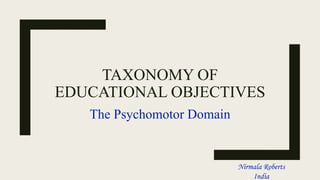
Taxonomy of Educational Objectives- The Psychomotor domain
- 1. TAXONOMY OF EDUCATIONAL OBJECTIVES The Psychomotor Domain Nirmala Roberts India
- 3. Taxonomy ⌗Taxonomy - A scheme of classification used to categorize things according to how they are related to one another ⌗Taxonomy of Educational Objectives – Defining and arranging levels of behaviour by their type and complexity ( by Psychologists & Educators)
- 4. ⌗Education Change in behaviour ⌗Behaviour = Knowledge, Skill, attitude ⌗Educational objectives = Behavioural objectives
- 5. Educational Objectives are divided into 3 broad domains/ categories… ⌗Cognitive Domain : Knowledge = Think ⌗Affective Doman : Attitude = Feel ⌗Psychomotor Domain : Skills = Do Skill Attitude The 3 domains, though existing separately, are interdependent
- 6. Educational/ Behavioural Objectives ⌗Classified into various levels – ☆ Low (simple) ☆ Medium (moderately difficult) and ☆ High (complex) levels ⌗Placed in a hierarchical form in each domain Learners must successfully achieve behaviours at the lower levels in order to move up the hierarchy to learn behaviours at the higher level
- 7. 1. The Cognitive domain ⌗Aim - To develop the mental skills and the acquisition of knowledge of the individual. ⌗The cognitive domain encompasses six categories – ☆ Knowledge ☆ Comprehension ☆ Application ☆ Analysis ☆ Synthesis ☆ Evaluation
- 8. Levels of Objectives in the Cognitive Domain Revised by Anderson & Krathwohl Higher Order Lower Order
- 9. The Affective Domain ⌗Processing and internalizing learning objects on an affective or emotional level. ⌗Internalization – Movement of feeling from general awareness level to unconscious assimilation into one’s nature, that consistently guides or controls one’s behaviour.
- 10. Acts consistently due to an internal belief Integrating a new value Classifying, prioritizing, discussing, examining Actively participating with internalizing Levels of Objectives in the Affective Domain by Krathwohl Being aware of the setting/ situation…..accepting it Committing & participating to the inputs, obediently and later willingly Higher Order Lower Order
- 11. The domains are interdependent…
- 12. Today, we shall discuss…..
- 13. 2. THE PSYCHOMOTOR DOMAIN (THE ‘MOTOR SKILL’ DOMAIN)
- 14. Psychomotor learning ⌗Psychomotor ability - A wide range of actions involving physical movement related to conscious cognitive processing. ⌗Psychomotor learning - Relationship between cognitive functions and physical movement. ⌗Psychomotor skills - Coordinated activity involving the arms, hands, fingers, and feet
- 15. Levels of Objectives in the Psychomotor Domain by Simpson (1972) Higher Order Lower Order Skilful performance and with complex movement patterns Use of sense organs to guide motor activities Readiness to take a particular type of action In the early stages – Imitation and Trial & error Responses become habitual, with ease & confidence Skill well developed, with good ability to modify Creating new movement patterns to fit the situation Higher Order Lower Order
- 16. Actions elicited without learning in response to stimuli Inherent movement patterns formed by combining reflexes Cognitive interpretation of stimuli to make adjustments to the environment Require endurance, strength, vigor, and agility which produces a sound, efficiently functioning body Communication through bodily movements ranging – posture… gestures, creative movements, facial expressions, role-play through sophisticated choreographics Acquisition of a degree of efficiency, to perform a complex task Harrow’s Taxonomy of Psychomotor Domain (1972) Higher Order Lower Order
- 17. Levels of objectives in Psychomotor domain – Moore (1998) Precision Imitation Manipulation Performs skills accurately, efficiently, effortlessly & automatically Performs skill independently Performs rudiments of skills with instructional support from teacher
- 18. Levels of Objectives in the Psychomotor Domain Simpson Harlow Moore
- 19. References ⌗ Basavanthappa B T, Nursing Education, 2nd Ed, Jaypee Bro’s Med pub., N Delhi, 2009, Pp – 433 – 435 ⌗ Bastable S. B, Nurse as Educator, 1st Ed, Jones & Barlett India Pvt ltd., New Delhi, 2020, Pp – 401- 407 ⌗ Sharma M C, Textbook of Nursing Education, 1st Ed, Jaypee Bro’s Med pub., N Delhi, 2013, Pp – 45 – 46
- 21. Practice session ⌗ Write educational objectives in the psychomotor domain for a lesson on “Administering IM Injection” – in the 6 levels – At the end of the class, the students are able to ☆ Perceive – Follows the procedure demonstration and reads the directions and related principles ☆ Follow a Set – Follows directions (asks questions), sensory attending, body language ☆ Perform a guided response – Imitates the act of recording of BP with hesitation, but with willingness under guidance of teacher ☆ Mechanically perform – Repeatedly performs BP recording with some ease and confidence (indicates mastery of the procedure) ☆ Perform complex procedures well – Automatically records BP with good skill and independence, without any guidance. ☆ Adapt skills for effective performance – Well developed skill. Can modify approach to client’s needs ☆ Develops originality at work – Can record BP in any situation through novel ways
- 22. Thank you
